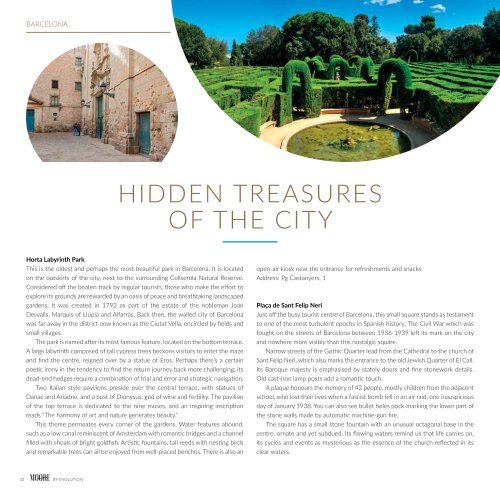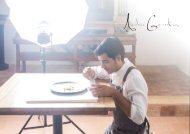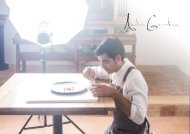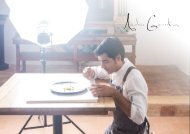You also want an ePaper? Increase the reach of your titles
YUMPU automatically turns print PDFs into web optimized ePapers that Google loves.
BARCELONA<br />
an ideal place to come with friends or family to enjoy the fresh air, and maybe<br />
bring a picnic. This is without doubt also one of the best spots in the city to enjoy<br />
panoramic views that stretch from the sea to the mountains beyond. See how<br />
many of Barcelona’s distinctive monuments you can spot along the skyline!<br />
The Greek style amphitheatre was designed <strong>by</strong> the Catalan architect Ramon<br />
Reventós, and its architecture is in the style of the Ancient Greek theatre of<br />
Epidaurus in Athens. This remarkable venue takes centre stage in the city-wide<br />
Grec Festival of performing arts which is celebrated every July in Barcelona.<br />
Open-air theatre, live music and performance from some of the most talented<br />
national and international companies fills its prestigious agenda. The theatre is<br />
rarely used during the rest of the year, but visitors can come and soak up its<br />
suggestive ambience.<br />
HIDDEN TREASURES<br />
OF THE CITY<br />
DISCOVER BARCELONA’S<br />
CHARMS OFF THE<br />
BEATEN TRACK.<br />
Horta La<strong>by</strong>rinth Park<br />
This is the oldest and perhaps the most beautiful park in Barcelona. It is located<br />
on the outskirts of the city, next to the surrounding Collserola Natural Reserve.<br />
Considered off the beaten track <strong>by</strong> regular tourists, those who make the effort to<br />
explore its grounds are rewarded <strong>by</strong> an oasis of peace and breathtaking landscaped<br />
gardens. It was created in 1792 as part of the estate of the nobleman Joan<br />
Desvalls, Marquis of Llupià and Alfarràs. Back then, the walled city of Barcelona<br />
was far away in the district now known as the Ciutat Vella, encircled <strong>by</strong> fields and<br />
small villages.<br />
The park is named after its most famous feature, located on the bottom terrace.<br />
A large la<strong>by</strong>rinth composed of tall cypress trees beckons visitors to enter the maze<br />
and find the centre, reigned over <strong>by</strong> a statue of Eros. Perhaps there’s a certain<br />
poetic irony in the tendency to find the return journey back more challenging; its<br />
dead-end hedges require a combination of trial and error and strategic navigation.<br />
Two Italian style pavilions preside over the central terrace, with statues of<br />
Danae and Ariadne, and a bust of Dionysus, god of wine and fertility. The pavilion<br />
of the top terrace is dedicated to the nine muses, and an inspiring inscription<br />
reads “The harmony of art and nature generates beauty.”<br />
This theme permeates every corner of the gardens. Water features abound,<br />
such as a low canal reminiscent of Amsterdam with romantic bridges and a channel<br />
filled with shoals of bright goldfish. Artistic fountains, tall reeds with nesting birds<br />
and remarkable trees can all be enjoyed from well-placed benches. There is also an<br />
open-air kiosk near the entrance for refreshments and snacks.<br />
Address: Pg Castanyers, 1<br />
Barcelona was a thriving town for craftsmen and this square was also the<br />
location of the shoemakers’ and coppersmiths’ guilds. The former building has<br />
now become a footwear museum with one of the quirkiest collections that you<br />
can visit in the city. Characteristic bars and restaurants also surround the square,<br />
making it an ideal place to take a break as you contemplate its history and plan the<br />
next stage of your sightseeing itinerary in the Catalan capital.<br />
Address: Plaça de Sant Felip Neri<br />
Plaça de Sant Felip Neri<br />
Just off the busy tourist centre of Barcelona, this small square stands as testament<br />
to one of the most turbulent epochs in Spanish history. The Civil War which was<br />
fought on the streets of Barcelona between 1936-1939 left its mark on the city<br />
and nowhere more visibly than this nostalgic square.<br />
Narrow streets of the Gothic Quarter lead from the Cathedral to the church of<br />
Sant Felip Neri, which also marks the entrance to the old Jewish Quarter of El Call.<br />
Its Baroque majesty is emphasised <strong>by</strong> stately doors and fine stonework details.<br />
Old cast-iron lamp posts add a romantic touch.<br />
A plaque honours the memory of 42 people, mostly children from the adjacent<br />
school, who lost their lives when a fascist bomb fell in an air raid, one inauspicious<br />
day of January 1938. You can also see bullet holes pock-marking the lower part of<br />
the stone walls made <strong>by</strong> automatic machine-gun fire.<br />
The square has a small stone fountain with an unusual octagonal base in the<br />
centre, ornate and yet subdued. Its flowing waters remind us that life carries on,<br />
its cycles and events as mysterious as the essence of the church reflected in its<br />
clear waters.<br />
Tibidabo<br />
Barcelona is framed <strong>by</strong> the Collserola mountain range which includes the<br />
distinctive mountain of Tibidabo. Its name means “I will give you,” and is a reference<br />
to the Biblical phrase spoken to Jesus <strong>by</strong> the devil, who took him to the highest<br />
mountain and tried to tempt him <strong>by</strong> showing all the opulent lands below. It is<br />
crowned <strong>by</strong> the Temple Expiatori del Sagrat Cor, a Romanesque church which was<br />
built between 1902-1961. This is illuminated <strong>by</strong> night, and its distinctive yellow<br />
outline high on the horizon can be seen from the city below.<br />
One of the world’s oldest amusement parks is also located here, with some<br />
original rides dating back to 1889. The top attraction is perhaps a large ferris<br />
wheel which slowly takes you higher and higher as you enjoy the beautiful views.<br />
Kids of all ages will love the rollercoaster and rides.<br />
Several snack bars include Enrique Tomás, which serves quality Spanish ham,<br />
and La Masia, with traditional tapas and dishes.<br />
To reach the top <strong>by</strong> public transport, take the FGC train from Plaça Catalunya<br />
to Tibidabo. The “Tramvia Blau” tram goes to the top of Avinguda Tibidabo, and a<br />
funicular rail completes the journey.<br />
Montjuïc and the Gardens of the Grec Theatre<br />
One of the most pleasant areas to explore in Barcelona is the mountain of Montjuïc,<br />
which can be reached in several ways. We suggest you take the spectacular cablecar<br />
ride from the Port of Barcelona, which offers great views. Montjuïc is known<br />
as the city’s “green lung”, as this large open space includes many parks and gardens<br />
such as the Botanical Garden, Laribal Garden and Cactus Garden.<br />
Our favourite corner of Montjuïc is the gardens of the Grec Theatre. These<br />
were created in 1929, with the rest of the features and installations designed<br />
to welcome the Barcelona International Exhibition. The gardens are exquisitely<br />
laid out with well-kept flowerbeds and details such as tumbling pergolas. A wide<br />
variety of plants, flowers and trees flourish here, including orange trees, tall<br />
palm trees and a herb garden full of colourful and fragrant lavender plants. It’s<br />
32 BY EVOLUTION 33














